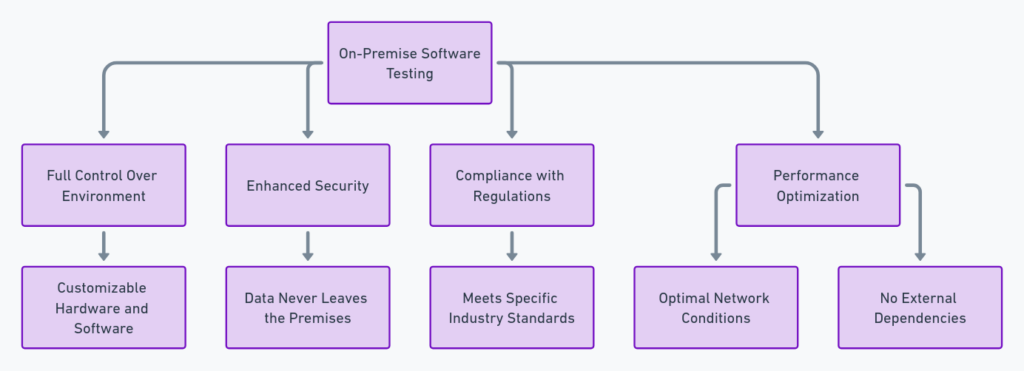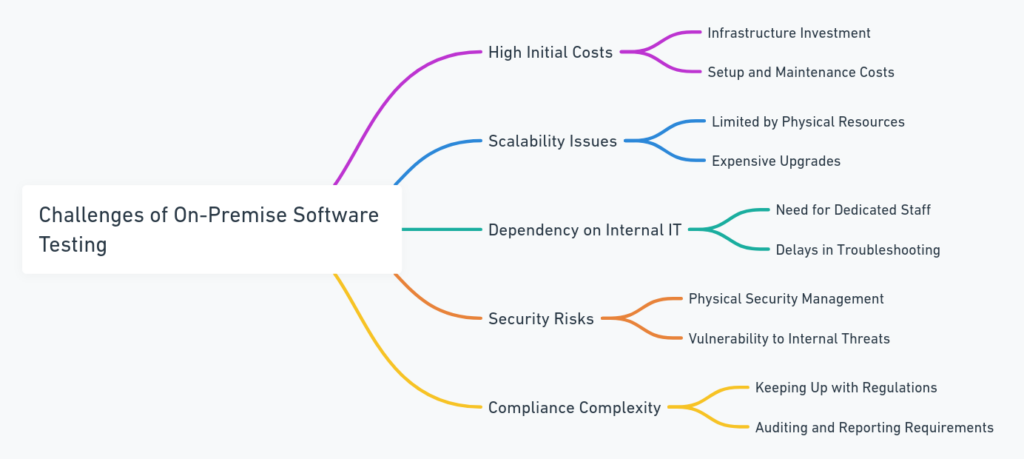In order to deliver flawless and robust products, on-premise software testing solution are essential. These solutions require the installation and maintenance of software testing infrastructure within an organization's physical premises.
On-premise testing, unlike cloud-based solutions, gives companies complete control over their software and hardware environments.
This configuration can result in enhanced security and customisation to meet specific organizational needs. This blog post will explore the benefits and challenges of software testing on-premises, comparing them to other testing environments.
This information will allow businesses to make an informed decision about the best setup for their needs.
What is an On-Premise Software Testing Solution?
On-premise software test is a scenario where the tools and resources for software testing are installed on the premises of an organization and used to run the tests using their own servers and hardware.
This approach is a traditional one that allows companies to control their testing environment, data, and tools. On-premise testing is different from cloud-based solutions, where data is stored externally.
The importance of on-premise testing
On-premise testing is essential for organizations who require strict data security, high levels of customization, and compliance with regulatory standards.
On-premise solutions are essential for sectors such as finance, healthcare and government where data security and confidentiality is paramount.
On-premise environments can be tailored to meet the needs of an organisation, improving compatibility with legacy system and enhancing test performance.
This is a crucial setup for companies that have complex or unique requirements which cloud solutions cannot meet.
Benefits of On-Premise Software Testing

Increased Data Security
On-premise software testing offers enhanced data security. Hosting everything internally eliminates the risk of external data breaches. This is especially important for cloud-based services, where the data is not under the direct control of the organization.
On-premises solutions enable companies to set up their own security protocols and tailor them to specific industry or internal requirements.
They can also manage access control efficiently. It not only safeguards sensitive data, but also enhances the defence against internal and external threats.
Greater Control Over Testing Environment
Software testing environments on-premise offer organizations the freedom to customize and control testing processes in a wide range. This includes:
- Selecting specific hardware and/or software to align with your company's goals and technical requirements.
- Setting up the system to reflect the exact operating environment where the applications are going to run. This will ensure that the software has been tested in real-world situations.
- Make manual adjustments to the infrastructure in order to adapt and address new testing requirements or unexpected issues that may arise during testing phases.
This direct control over the testing environment improves the reliability of tests, allows for flexibility in managing resources and provides the opportunity to optimize the use and reconfigure them as needed, without external dependencies and delays.
The environment can also be maintained over a long period of time, allowing for a stable and consistent testing regime, which can be adjusted to meet the changing demands in the business and technology landscapes.
This level of control can be especially beneficial for large or complex projects that require high levels of precision.
The Challenges of On-Premise Software Testing

High Initial Investment
The upfront costs of deploying on-premises software testing solutions are substantial. To handle comprehensive testing, organizations must invest in high-end servers and hardware.
The initial cost of licensing testing environments and tools can also be significant. On-premise solutions require a financial commitment from the start, unlike cloud-based setups that operate on a "pay-as you go" model.
This can limit the ability of small firms and startups to adopt the approach because they have limited capital.
Maintenance and Upkeep costs
In addition to the initial cost, software testing facilities on premises require ongoing maintenance and administrative overhead.
The costs of regular hardware maintenance, security updates and software updates are increased by the need for dedicated IT resources and staff.
Cloud providers, on the other hand, typically handle such tasks and reduce the burden placed on internal teams.
In comparison to other testing solutions, the need to constantly monitor system performance in order to prevent downtime and breaches will result in higher costs over time.
Scalability Issues
Scaling up on-premise solutions is both expensive and complex. When testing requirements increase, organizations have to manually upgrade their hardware systems and software to accommodate the new requirements.
Not only does this lead to additional investments, but it also causes operational disruptions. In addition, scaling up is always delayed, since it takes time to set up and procure new infrastructure.
This delay and inflexibility is detrimental to an organization in fast-paced environments, where scalability and responsiveness are crucial.
Comparing On-Premise Testing to Other Solutions
| Aspect | On-Premise | Cloud-Based | Outsourcing | Hybrid |
|---|---|---|---|---|
| Flexibility | Limited | High | Variable | High |
| Scalability | Manual upgrades required | Instantly scalable | Dependent on vendor | Flexible, with constraints |
| Cost | High initial and maintenance costs | Lower upfront, pay-as-you-go | Lower staffing and training costs | Mix of both models |
| Security | High, controlled internally | Depends on provider | Risky, less control | High for critical data |
| Maintenance | Full internal responsibility | Managed by provider | Managed by vendor | Complex, dual management |
| Data Compliance | Easier to manage | Provider-dependent | Vendor-dependent | Needs careful management |
| Operational Control | Complete | Reduced | Limited | Balanced, split control |
Cloud-Based Testing
Cloud-based testing is more flexible and scalable than on-premise options. Cloud services allow companies to access a variety of testing environments, tools and other resources without having to invest in hardware up front.
The instantaneous scalability allows organizations to adapt resources according to their immediate needs. Cloud providers also handle updates, maintenance and security.
This reduces the workload on internal IT departments. It requires a constant internet connection, and it can raise questions about data security or compliance depending on the provider policies and the sensitiveness of the data to be tested.
Outsourcing Testing
Third-party vendors can perform software testing for organizations through outsourcing. It is especially beneficial to companies that lack the expertise or resources necessary to perform comprehensive testing.
Outsourcing reduces costs related to staffing, training, and gives access to advanced technologies and specialized skills. However, the challenge is managing security and quality standards as there are no direct controls over testing as with on-premises or cloud solutions.
Hybrid Model
Hybrid models combine elements from both on-premises and cloud-based software, with the goal of maximizing the benefits of each while mitigating their limitations.
The cloud can handle non-critical, scalable testing tasks while sensitive data and critical processes are retained on site under direct control.
This model is appealing to many businesses because it offers a good balance between security, scalability and cost. However, the complexity of managing multiple setups can create operational and integration challenges.
Book a Demo and experience ContextQA testing tool in action with a complimentary, no-obligation session tailored to your business needs.
The conclusion of the article is:
On-premise software testing is a viable option for many companies, particularly those that have strict requirements in terms of security, regulatory compliance, and performance.
Although the initial costs may be higher than cloud-based solutions due to maintenance, the ability to customize infrastructure and control data often makes up for these differences.
Companies can optimize their software development cycle and achieve better software quality by carefully assessing the needs and resources of their organization.
It is important to periodically re-evaluate your decisions as technology changes to keep up with new threats, industry standards, and opportunities.
Also Read - How to test pega systems?
We make it easy to get started with the ContextQA tool: Start Free Trial.
